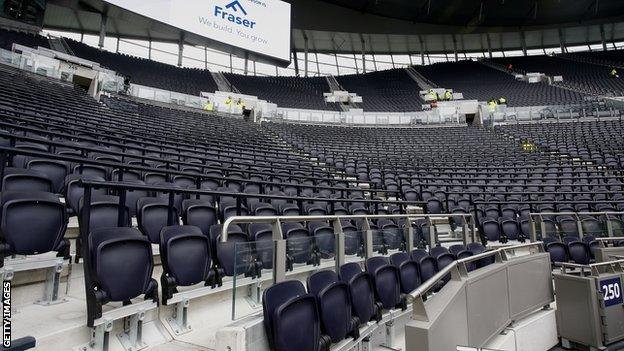No safe standing trials this season despite call for 'tolerance in existing policy'
- Published

Tottenham's new stadium has seating areas that have been "future-proofed for safe standing"
Safe standing will not be trialled in England's top two leagues this season, despite a new report suggesting controlled tests would have value.
The government-commissioned report said more evidence was required before safe standing could be adopted.
Standing in English football's top two tiers is illegal after recommendations made following the 1989 Hillsborough disaster when 96 fans died.
But evidence will be gathered in stadia outside the top two tiers this season.
The report by CFE research, commissioned for the Department of Culture for Media and Sport, said new evidence could be gathered but it would require "tolerance within existing policy to trial different standing areas".
It suggested that "randomised control trials could demonstrate impact of alternative accommodation".
The Sports Ground Safety Authority will look into how safe standing is implemented at British and European clubs, and how persistent standing is managed elsewhere.
But it understood that would not include carefully managed trials in stadiums where a form of rail seating exists, such as Tottenham and Wolves, as such experiments would be against the law.
The latest development means safe standing will not come into force until at least 2021, but once evidence has been gathered there is likely to be a public consultation, meaning it could be 2022 before safe standing might be introduced.
Instead of the "randomised control trials" suggested in the report, evidence will be gathered at the likes of Celtic, Shrewsbury Town, Wycombe Wanderers and Oxford United, who all offer safe standing alternatives outside the Premier League and Championship in England.
The Football Supporters Federation has been among those to call for safe standing, while the Football Association, Premier League and EFL have all said they would support clubs' choice to implement safe standing if local authorities allow it.
The report by CFE research said there was no "robust body of evidence to suggest standing in its current form, either on traditional terracing or modern dual purpose options, is any more or less safe than sitting".
It added: "The risks associated with standing in seated areas are greatest at moments of excitement, which is not mitigated by the all-seater policy.
"However, any change to current policy must be based on robust evidence that such a change would ensure equivalent or improved spectator safety.
"There is significant scope for further research to build this evidence base, requiring tolerance within existing policy to trial different standing areas - alongside monitoring clubs taking different approaches to the management of standing - to provide evidence of impact."
A DCMS spokesperson said: "Over a million people watch live football at a ground every week and their safety is paramount.
"The independent review on standing at football found that more evidence is clearly needed before any change to the current all-seater policy can be properly considered.
"The Sports Grounds Safety Authority will be gathering this evidence over the course of the football season. Their report will be published next year."